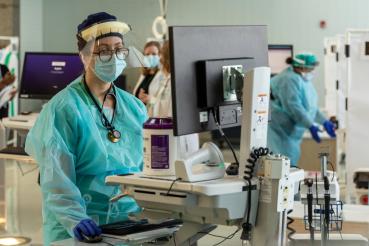Testing has been one of the top challenges — and top priorities — for hospitals and health systems across the country during the COVID-19 pandemic. Since March, Rush University Medical Center has been a leader in the Chicago area in developing, expanding and evolving in-house testing efforts.
On Friday, Nov. 13, the Medical Center performed its 100,000th test for COVID-19. This milestone would have not been possible if not for the hard work and scientific skill of Rush’s Clinical Microbiology Laboratory team, which took on the crucial assignment of developing an in-house test for SARS CoV-2, the virus that causes COVID-19, at the beginning of the pandemic and later implemented more expansive testing methods quickly.
Launched on March 16, the Medical Center’s in-house test for COVID-19 was developed in less than two weeks, an effort led by Haiying Li, senior research scientist, and Debra Schejbal, microbiology lab supervisor. The team was able to use the first in-house test just 10 days after beginning work on it, initially giving Rush the ability to test up to 87 samples a day.
A multidisciplinary team of specialists worked together through a time- and labor-intensive process to ensure the test was accurate and ready to use immediately. Once the test was created, they submitted it to the U.S. Food and Drug Administration for approval through emergency use authorization. This accelerated effort normally would have taken months to complete.
“This process and timeline was unprecedented,” said Dr. Mary Hayden, chief of the Division of Infectious Diseases and director of the Clinical Microbiology Laboratory.
The in-house test allowed the Medical Center to perform COVID-19 testing before the release of Abbott Laboratories' m2000 test, which allowed for more expansive testing. The m2000 platform already was in use at Rush for molecular detection of other viruses prior to the COVID-19 pandemic, which allowed the Medical Center to transition easily to it to test for the COVID-19 virus.
The team then adjusted their procedures, trained technicians to perform the testing and rearranged staff schedules to increase testing capacity. Once the m2000 test was in place, Rush was able to significantly increase testing to 500 samples per day.
After implementing the m2000 test, the team also began using COVID ID Now, Abbott’s point-of-care test (a test that can both be given and yield results at the time and place care is provided) and a third test, the Cepheid GeneXpert Xpress. In October, the lab installed the Alinity m, a state-of-the-art automated molecular diagnostics analyzer that nearly doubled lab capacity. Between all of these tests, the Medical Center has been able to test 6,100 people a week, allowing it to expand testing to include first responders.
Because of their hard work, the lab’s COVID testing volume to date has increased 50% over the total test volume for the lab for last calendar year.
“This is a huge accomplishment, especially given that our staffing has not increased,” said Hayden. “The clinical microbiology staff members have worked very hard. They can feel proud that their work contributed to improved patient care and reductions in infection transmission for thousands of persons, thereby saving human lives.”
As the pandemic continues and the Chicago area experiences another, even larger COVID-19 surge than the initial wave in the spring, the microbiology team’s hard work made it possible for the Medical Center to continue large-scale testing when it’s needed most. This capacity allows patients who test positive for COVID-19 to get care earlier and those who have been exposed to them to quarantine to help reduce the spread of the virus.
“Testing will be especially important as we enter the winter respiratory virus season,” said Hayden. “It is critical so that individual patients can be treated appropriately and important for public health, to ensure that an infected person can be isolated and prevent further transmission.”




